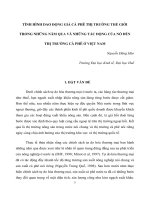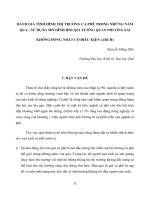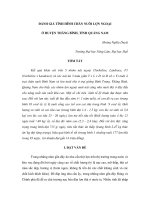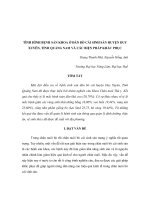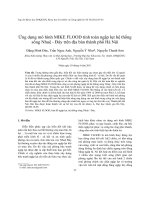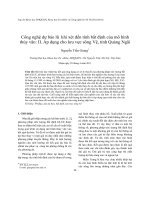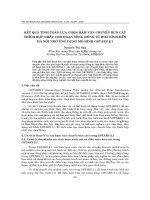Báo cáo nghiên cứu khoa học: "tình hình sâu răng học sinh trung học trong Huongtra huyện, tỉnh Thừa Thiên Huế" doc
Bạn đang xem bản rút gọn của tài liệu. Xem và tải ngay bản đầy đủ của tài liệu tại đây (103.71 KB, 9 trang )
143
JOURNAL OF SCIENCE, Hue University, N
0
61, 2010
DENTAL CARIES SITUATION OF SECONDARY SCHOOL STUDENTS IN
HUONGTRA DISTRICT, THUA THIEN HUE PROVINCE
Nguyen Huu Hai, Nguyen Van Tap
College of Medicine and Pharmacy, Hue University
SUMMARY
Dental caries are a common disease in Viet Nam and all over the world. It affects
aesthetics as well as the function of mastication. If the caries are not treated properly, it can
cause dangerous complications. Today, dental caries prevention is effectely implentmented in
many developed countries. Meanwhile, the dental caries prevalence in developing countries is
very high because of the inadequacy of prevention measures. In Viet Nam, the national oral
health survey in 2002 shows that the dental caries prevalence in different ages are: 83.7% in 6;
56.6% in 12; 67% in 15; 75 – 89.7% in adults. The study aims at identify the dental caries
prevalence of secondary school students in Huong Tra district in 2009 and study some factors
relating to dental caries. The Cross – sectional descriptive study in the secondary school
students in Huong Tra district, 2009 was conducted. A stratified cluster sample was used in this
study. There were 663 students participating in this study, who were divided into 2 groups: one
living in the town, the other living in communes. The study showed that the dental caries
prevalence was 84.6 % in secondary school students, the mean of DMF and DMFS were 3,00
and 5,06; the oral hygiene situation and living places were factors relating to dental carie;, and
there was not a significant relationship between dental caries and the following factors: age,
sex, ages of parents, number of children in the family, water source, knowledge and practice of
oral health care.
1. Introduction
Dental caries are a common disease in Viet Nam and all over the world. It
affects aesthetics as well as the function of mastication. If the caries are not treated
properly, it can cause dangerous complications. Nowadays, dental carie prevention is
effectely implentmented in many developed countries. Meanwhile, dental carie
prevalence in developing countries is very high because of the inadequacy of
prevention measures.
The measures for preventing dental caries recommended by the WHO are:
Fluoride water, oral health education, reasonable diet, and regular dental examination.
In Viet Nam, the oral health promotion program has been implemted for 15
144
years but oral deseases prevalence is still high. The national oral health survey in 2002
showed that the dental caries prevalence across age groups were : 83,7% in 6; 56,6% in
12; 67% in 15; 75 – 89,7% in adults.
The aims of this study are to identify the dental caries prevalence of the
secondary school students in Huong Tra district , 2009 and study some factors relating
to dental caries.
2. Methods
2.1. Research design: Cross – sectionnal descriptive study in the secondary
school students in Huong Tra district, 2009.
2.2. Sample: The stratified cluster sample was used in this study. There were
663 students participating in this study, who were divided into 2 groups: one living in
the town, the other living in communes.
2.3. Contents and variables of the research
- Dental carie prevalence
- DMFT, DMFS index
- Teeth group caries clasification
- Related fators: age, gender, oral hygiene situation, mean age of parents,
number of children in family, educational level of parents, water resource, knowlegde
and practice of oral health.
- Caries diagnosis belongs to WHO dental caries criteria
2.4. Research instruments
- Examiner: the author and a dentist who works in Huong Tra health service
center.
- Equipment:
+ Questionnaire, examination paper.
+ A Mirror, explorer, and precelle were used to examine.
2.5. Statistical method: Data was analysed using SPSS 17.0, P value ≤ 0.05 was
used to analyse the significant difference between the variables.
145
3. Results
3.1. General characteristic of study population
Table1. Gender and Age of study population
Gender
Age
Male Female Total
n % n % n %
12 57 8,6 % 86 13% 143 21,6%
13 78 11,8% 97 14,6% 175 26,4%
14 62 9,4% 89 13,4% 151 22,8%
15 94 14,2% 100 15,1% 194 29,2%
Total 291 56,1% 372 43,9% 663 100%
Table 2. Location of study population
Location n %
Urban 335 50,5%
Rural 328 49,4%
Total 663 100%
3.2. Dental caries Status
Table 3. Dental caries prevalence
Caries n %
No caries 102 15,4
Caries 561 84,6
Total 663 100
Table 4. Caries experience (DMFT and DMFS)
DMFT.
n Max Min Total Mean SD
663 12 0 1992 3.00 2.31
DMFS.
n Max Max Total Mean SD
663 29 0 3589 5.42 4.94
146
Table 5. Caries prevalence among teeth groups
Teeth
group
Upper
incisors and
canines
Upper
molars and
premolars
Lower
incisors and
canines
Lower
molars and
premolars
p
n % n % n % n %
0.000
Caries 42 6,3 319 48,1% 4 0,6% 538 81,1%
No caries 621 93,7% 344 51,9% 659 99,4% 125 18,9%
Total 663 100% 663 100% 663 100% 663 100%
3.3. Relation factors to caries
Table 6. Caries and DMFT by gender
Gender
Caries
Male Female Total p
Prevalence
n 245 316 561
0.789
% 84,2% 84,9% 84,6%
DMFT 2.86 3.12 3.00 0.152
Total 291 372 663
Table 7. Caries and DMFT by ages
Ages
Caries
12 13 14 15 p
Prevalence
n 131 145 125 160
0.076
% 91,6% 82,9% 82,8% 82,5%
DMFT 2.93 2.77 3.09 3.20 0.315
Total 143 175 151 194 663
147
Table 8. Caries and DMFT by location
Location
Caries
Urban Rural p
Prevalence
n 302 259
0.000
% 90.1 % 79.0 %
DMFT 3.52 2.48 0.000
Total 335 328 663
Table 9. Caries and DMFT by oral hygiene
Oral hygine
Caries
Good fair Moderate Bad p
Prevalence
n 7 163 258 133
0.000
% 50 72.1 89.6 98.5
DMFT 1.50 2.10 3.27 4.11 0.000
Total 14 226 288 135 663
Table 10. Caries and DMFT by number of children in family
No.of children
Caries
1 2 ≥ 2 p
Prevalence
n 18 113 427
0.553
% 90.0% 86.9 % 83.9 %
DMFT 3.45 2.97 2.99 0.677
Total 20 130 509 659
Table 11. Caries and DMFT by Parents’ education level
Ecation level
Caries
Primary Secondary
High
school
University p
Prevalence
n 137 245 94 52
0.190
% 80.1% 84.8% 89.5% 86.7%
148
DMFT 2.79 2.94 3.60 2.82 0.029
Total 171 289 105 60 625
Table 12. Caries and DMFT by using water resource
Water resource
Caries
Factory Raining Well Other p
Prevalence
N 281 11 268 0
0.187
% 84.4% 91.7% 84.8% 0
DMFS 3.01 3.25 3.01 0 0.632
Total 333 12 316 2 663
Table 13. Caries and DMFT by oral health knowledges
Knowledge
Caries
Good, fair Moderate Bad p
Prevalence
N
136 180 245
0.879
% 83.4 85.3 84.8
DMFS 3.02 3.22 2.84 0.190
Total 163 211 289 663
Table 14. Caries and DMFT by oral health care practice
O.H.C practice
Caries
Good, fair Moderate Bad p
N 174 315 68
0.986
% 84.5 84.7 84.0
DMFT 3.18 2.94 2.78 0.356
Total 206 372 81 659
4. Discussion
The dental caries experience among secondary schoolchildren in Huong Tra
district is high. In our research, we use diagnostic criteria of WHO that means only
149
dental caries cavity is diagnosed. If we use new diagnostic criteria suggested by Koch,
earlier dental caries diagnosis, the dental caries prevalence will be higher.
According to foreigner reseachers, the dental caries experience in our reacher is
in the range of the developing countries. Nowadays, this ration rests very low in the
developed countries.
The dental caries experience reseacher of WHO in 2004 shows that the
distribution and serious level of dental caries vary to regions and countries in over the
world. This study also shows the increasing of dental caries prevalence in developing
contries. This problem was explained by the acceleration of suger consumption and
fluoride indequate. In the opposite, the dental caries experience tends to decreasing in
the recent 20 years. This result due to public health measures containing effective
fluoride using, living condition change, life style and oral health care capacity.
The reseache in southern of ThaiLand in 2001, the dental caries prevalence in 6
years – old is 96,3%, dmf: 8,1 and the dental caries prevalence in 12 years- old is 70%,
DMF: 2.4. ThaiLand has geographic position, economy, culture and society similar to
Viet Nam and the dental caries experience in the same range with Viet Nam.
In comparision to the VietNamese reseaches in 2001, 2002, the dental caries
experience among schoolchildrens tends to increasing. This ratio in 2001 – 2002 is 60 –
70%, meanwhile in our reseacher 84,6 % and 86 – 92 % in Ho Thi Thanh study
( 2009 ) in DaNang city. The dental caries goes up with the economic and social
development. The cause of dental caries is mainly eating habits and oral hygene. The
products containing sugar such as candy, biscuits, beverage is more and more abudant
kinds. Futhermore, the fluoride water has not been implemted yet in our country and
school oral health care program has not been covered yet so that the dental caries
prevalence increases obviously.
About dental caries complication such as : pulpitis, pulp necrose, periapical
imflammation, in our reseache: 43%. Oral health care of children has not been
considered approtiately by parents. Majority of children consulted in the late period of
dental caries. The school oral health care in HuongTra has not developed so the
examination, detection and treatment dental caries is not frequent.
In Hương tra district, there is not the preventive dental care programme in the
school so the schoolchildren have not been got oral health care and education. There are
only 4 dentists, 2 dental practicians and 1 dental nurse serving about 117.000 inhabitants.
That means 20.000 inhabitants are served by 1 dental practitioner. This ratio is 2000 / 1
dental practitioner in many developped countries.
The dental caries prevalence is high but the number of patient to dentist is low.
In our research, the percentage of secondary schoolchildren consulted regularly in
150
dentista for oral health care is 14,2 %. A great number of children were treated dental
caries at home by salt water or medecines in pharmacy.
The 6th teeth dental caries are the most common. These teeth are the important
ones of the dental arch so it is neccessary to pay attention to them in oral health care.
The oral hygien status has the significiant association to dental caries experience.
There are the same results in many researchs that demonstrates the oral hygien play a
important role in the etiology of dental caries.
5. Consclusion
(1) The dental caries prevalence was 84.6 % in secondary school students.
(2) The mean of DMF and DMFS were 3.00 and 5.06.
(3) In our research, there was a statistically significant relationship between
dental caries and oral hygiene situation and living places.
(4) There was not a significant relationship between dental caries and the
following factors : age, sex, age of parents, number of childrens in the family, water
source, knowledge and practice of oral health care.
(5) The dental caries prevalence and DMF, DMFS were very high in secondary
school students of Huong Tra district.
(6) It is necessary to implentment an oral health care program in the secondary
school.
REFERENCES
1. Hue Odonto – Stomatology departement (2007). “ Oral health basis survey ”.p.24
2. Trịnh Đình Hải (2007) “Oral health care in primary school ” p.1 – 7.
3. Đinh Thanh Huề (2008) “Epidermiology” Tp68
4. Phạm văn Lình, Đinh Thanh Huề (2008) “Health sciences reaserch method”, Hue
University publisher 2008, p.94.
5. Trần Tấn Tài (2006) “Dental caries and related factors among high school students
Hue City”, Medical master thesis.
6. Wikipedia (2008) , “Huong tra encyclopedia”
7. Ling Z, Petersen.P.E., Hong – Ying.W, Jin- You.B, Bo- Xue.Z, (2005). International
Dental Journal . No.55, p.231.
8. Petersen. P.E, Bourgeois. D, Ogawa. H, Estupinan- Day S, Ndiaye. Charlotte. (2005).
“The global burden of oral diseases and risk to oral health”. Bulletin of the
WHO.Vol.83, No.9. Genebra 9. 2005.p.1
151
9. Moynihan.P, Petersen.P.E. (2009). “Diet, nutrition and prevention of dental diseases”,
Public Health Nutrition, 7 ( 1A ), p.201.
10. Varenne. B, Petersen.P.E., Ouattara. S.,(2004). “Oral health status of children and
adults in urban and rural areas of Burkina Faso, Africa.”, International Dental
Journal, Vol.54, p. 83- 89.
11. Kandelman.D (2000). “La dentisterie prevention de l’an 2000”. Information
dentaire, No 31, 9/ 1999.

